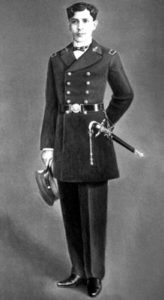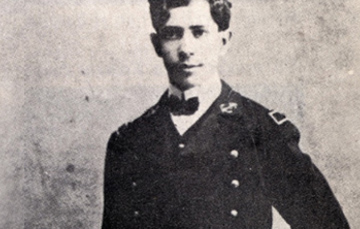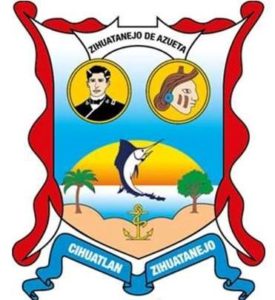By: Patricia Ann Talley, Editor
The official name of the municipality of Zihuatanejo, Guerrero is “Zihuatanejo de (of) José Azueta.” The image of José Azueta is also on the city emblem (escudo). The city of Veracruz is also named after him (Veracruz de José Azueta), and he is included in history books and museums throughout the country. Every year, on April 21, the country pays tribute to the Heroic Defense of Veracruz:
In Mexico, the name of José Azueta will forever be remembered as a significant symbol and permanent example of patriotism and loyalty. But, many foreigners know little about him or the historic times that he represents.
Lieutenant José Azueta Abad: 1895-1914
Zihuatanejo de José Azueta is the official name of the municipality. The image of José Azueta is also on the Zihuatanejo city emblem (escudo).
The world is familiar with the historical accounts of the invasion of Mexico by the United States in the mid-1800s (Mexican American War: 1846-1848). During this conflict, there were six young Mexican cadets, ranging in age from thirteen to nineteen, who died in 1847 defending their military academy at Chapultepec Castle in Mexico City. These cadets are honored in Mexico’s history as the Niños Heroes (The Boy Heroes).
But foreigners are probably less familiar with the second invasion of Mexico in 1914 when the USA took occupation of the Port of Veracruz. It is this battle in which the young Mexican Navy Lieutenant José Azueta became famous for his role in defending his country and where he was fatally wounded.
José Azueta, for whom Zihuatanejo and Veracruz are named, is one of the most revered national heroes in Mexico.
José Azueta was born on May 2, 1895, in Acapulco, Guerrero. He was the son of Naval Commodore Manuel Azueta Perillos and Señora Josef Abad. At eleven years of age, José Azeta and his family moved from Acapulco to the port city of Veracruz, a key military point for the country. Little by little, the boy became interested in military life due to the influence of his father. He enrolled in the Escuela Naval Militar de México (National Naval Academy of Mexico), which was the most prestigious in the nation.
Under the guidance of his father, along with his personal motivation, and the best naval instruction in the country at that time, he learned the secrets and disciplines of military combat. He embarked upon his first military ship, “Yucatán” on June 18, 1911. Later, at the Military Base in Veracruz, he progressed to the rank of Tactical Lieutenant of the Artillery and was distinguished for his loyalty, honesty, and valor.
But these were the times of political unrest in Mexico and when the country faced international threats from the United States. The Mexican Revolution (Revolución mexicana) was underway (1910-1920); a major armed struggle that radically transformed Mexican culture and government. The United States had invaded Mexico and had taken possession of half the country during the mid-1800s, and was also involved in Mexico’s revolution, first supporting and then repudiating various regimes- depending on U.S. diplomatic or business interests.
In 1911, Mexico’s longtime head-of-state, Porfirio Díaz, was deposed. Díaz had been strongly aligned with U.S. economic interests that then controlled 90 percent of Mexico’s mineral resources, its national railroad, its oil industry, and increasingly, its land.1 Middle-class and landless Mexicans were resentful of this foreign occupation and control; they overthrew Díaz and installed reform champion, Francisco Madero, as president. Not long after, the Mexican military, under the leadership of General Victoriano Huerta, deposed Madero and executed him.
In 1913, U.S. President Woodrow Wilson declared that he would never recognize the Huerta government. He sent two diplomatic envoys to Mexico City demanding Huerta’s resignation. Mexico’s political leaders did not comply. So in 1914, having failed at diplomacy, U.S. President Woodrow Wilson sent a small naval invasion force to the Port of Veracruz to force Mexico to change its presidency.
Nineteen-year-old Lt. José Azueta was on duty at the Naval Academy in Veracruz on April 21, 1914, the first day of the U.S. invasion. He manned a machine gun placed outside of the building facing the incoming American troops, where he fought valiantly to defend his country!
A statue of José Azueta depicting him manning a machine gun in defense of his country stands prominently at the Zihuatanejo pier alongside the Naval Station. Photo by: Margaret Reid.
On April 24, Lieutenant José Azueta was promoted to captain by Mexico’s president for his performance in combat. On April 29, he was awarded a gold medal. On May 1, he was awarded the 3rd Class Military Merit Medal. José Azueta died of his wounds on May 10, Mexico’s Mother’s Day.
Brave men and women do not belong to any one country.
References:
Raúl Román Román, Memoria Costeña. Zihuatanejo, Guerrero: By the Author. 2010.
Centenario de la Gesta Heroica de Veracruz http://www.centenario21abril.gob.mx/index.html
Footnotes:
- Joshua Zeitz, “The Last Time the U.S. Invaded Mexico,” Politico Magazine, February 4, 2017: http://www.politico.com/magazine/story/2017/02/the-last-time-the-us-invaded-mexico-214738


